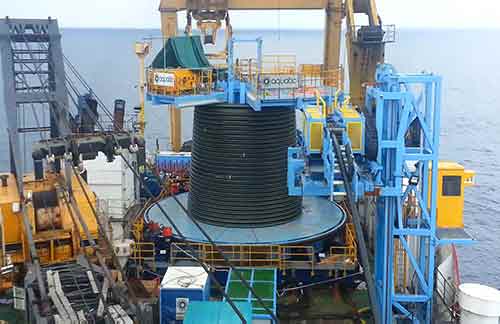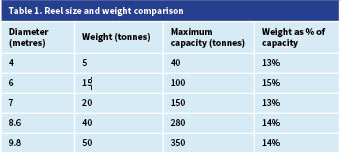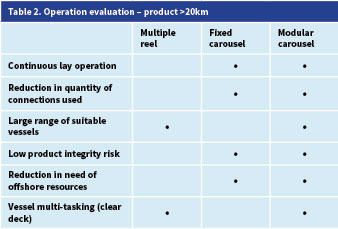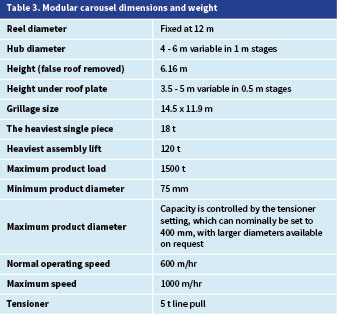Modular carousels: carpe diem!
David Tibbetts, Aquatic Engineering & Construction Ltd, an Acteon company, explores a technical comparison of modular carousel systems versus reel-based installations.
Marine installation operations are trending towards deeper water, with projects in the 2000 - 3000 m water depth becoming commonplace; consequently, umbilicals and cables are also getting longer, requiring increased capacity reels. Installation, replacement or recovery works for this type of product requires specialist equipment to accommodate the increasing bulk of the flexible products being installed, without compromising the performance of the vessels which carry them.
This technical challenge sparked the development of new and innovative modular carousel designs. Aquatic’s innovative 1500Te fully modular carousel solution was brought to market following research across its customer base to determine its feasibility and subsequent demand. It was designed to maximise product capacity, minimise vessel days and maintain operational efficiency in the most challenging of marine installation projects. On its maiden project, the carousel was successfully used to install 9.7 km of 218 mm diameter umbilical in the South Belut field offshore Indonesia for ConocoPhillips, working with Kreuz Subsea. Now field-proven, it is earning its reputation as a game-changer in the offshore subsea industry.

The Aquatic carousel system installing 3.7 km of 218 mm dia. umbilical in the South Belut field.
The carousel was designed for the widest possible range of vessels, customers and project variations to maximise its potential future use worldwide. Aquatic chose to place its carousel ‘reel’ horizontally to allow maximum product capacity whilst minimising the impact on the vessel. In turn, this maintains operational efficiency in both shallow and deep waters. The additional benefit of modularity further reduces repositioning costs and takes the equipment off the scheduling critical path.
Reel based installation
Reel based installation is the most common approach for installing short to mid-length flexible products where the number of offshore connections can be limited to minimise the risk of introducing too many potential points of failure. As the product length increases, there is a tendency to move to carousel-based installation because either connections can be made and tested during transpooling onshore or the product can be manufactured in a greater length and spooled directly onto the carousel.

Installing directly from a reel is typically more cost-effective than using a carousel, provided that sufficient capacity is available and multiple trips are not required. There is a desire within the industry to push reel diameter and reel drive capacity beyond their current limits in an attempt to ensure reel-based installation remains a feasible option as tie-backs get longer. As with most developments in technology, the complexity of the task becomes more significant as equipment size and capability are increased.
The challenge goes like this: Adding more steel to a reel to increase its size adds weight, which then requires additional structural strengthening, which in turn adds more weight… this continues until an acceptable equilibrium is reached. The weight gain has to be handled by the reel drive system, which needs to be larger to cope with the reel diameter and stronger to cope with the weight of the additional product that the reel can handle. Subsequently the weight of the whole system needs to be supported by the vessel deck, which is limited by its own design, resulting in a larger equipment footprint to spread the load within the confines of the vessel deck capacity and further consideration of support equipment positioning.

These key variables have to be optimised to determine the upper limit of reel-based installation technology. This method of installation must remain accessible to ensure the greatest selection of vessels remain available to choose from, without costly modification. Inevitably, the vessel deck capacity must be used as the fixed starting point from which design and development can proceed since this parameter is the most complex and most expensive, to change.
Limitations
Aquatic delivered a technical paper at ASME’s 34th International Conference on Ocean, Offshore and Arctic Engineering (OMAE) in June this year which explored the complexities of this topic in great detail. When considering the limitations of multiple reel installations, it is already clear that as the number of reels increases, so does the project complexity. If one is able to increase the size and capacity of the installation reels, this complexity still exists but by increasing the diameter/volume of the reel, and therefore the amount of product that it can hold, it is possible to reduce the number of reels and offshore connections but at the expense of using up more deck space for the reel drive system. This also leads to a higher equipment cost and increased vessel instability, resulting in a narrower window of opportunity for installation and greater reel packing complications, particularly when the end connection is packed in its own partition creating an unbalanced reel. There are also physical constraints already placed on the vessel in terms of its crane reach, track length, crew space and so on. All of these challenges help demonstrate why the industry standard for reel-based installation has remained at 500Te and 11.4 m for as long as it has (which is, incidentally, a standard which Aquatic championed in 2009).

So in the interests of balance, this article will quickly examine the limitations of carousel installations for a comparison with reels. One of the fundamental issues with carousel installation is that is must be considered at the planning stage of the deployment system. A significant part of the advantage of a carousel is lost when the product is designed around reel installation. Even with the introduction of very large reels, it is likely that multiple reel assemblies will be required. The design of complex end fittings removes the need to carry out jointing operations in field, but the need to ensure the end fittings are quick to assemble and offer the highest possible integrity inevitably leads to a far more expensive and time consuming solution than having a single length of product. Consequently, the use of a carousel is an early stage decision and only in cases where the transit to the operations area represents a high percentage of the duration is this revisited later in the process.
Carousel systems
On the whole, carousels tend to be purpose-built into a standalone vessel or else they are basket-style with inherent functional limitations. In terms of a project’s budget, mobilisation of a carousel will usually include significant relocation costs of the vessel, while carousel vessels themselves are generally locked into long-term contracts and are generally only capable of performing a single task in the field (i.e. not suitable for other field operations before or after the carousel has been utilised). With deeper waters in mind, carousels may also be too costly for mid-length tiebacks or those on the upper limit of multiple reel usage.
So what exactly does the market really want from a carousel? High on the list of priorities is the ability to transport a carousel easily from one location to another, which is a characteristic of all Aquatic equipment. In bringing its own carousel to market, it was a given that a fully modular build, to facilitate transportation to any part of the world to ensure this advantage, was top of the list to make hiring it straightforward for global customers. This portability also causes a lesser impact on where the ship is located and means that it can be used on a much wider range of host vessels.

With customers operating in all parts of the globe, a carousel needs to have the option of an enhanced range of mobilisation ports; in other words, there needs to be the ability to handle the carousel, equipment and product at more compact quaysides which are being utilised more regularly as the offshore industry moves into more regions with limited infrastructure – South East Asia and the Middle East being prime examples.
There should be options on the size and number of lifts to mobilise; the carousel should also have the ability to be adjustable in packing height and core diameter to cater for different bend radii and improved centre of gravity. The addition of a level winder unit with incorporated tensioner completes the package by providing the ability to spool under tension.
Reel design and deployment a fundamental part of the installation process
The question whether the same might be achieved with reels is a fair one. Certainly, there are a number of areas of development in the sphere of multiple reel installation. In terms of reel size and specification, for example, although the current ‘standard’ is 11.4 m, there are examples of installations with reels up to 12.3 m which Aquatic has been involved in, and there are plans afoot within the industry for reels up to 14 m in diameter. Naturally enough, the weight of the reel will increase significantly if there is an increase in size, owing to its physical shape and the very real need for additional structural support. The challenge those focusing on reels face is that reels are still viewed merely as consumable items, which creates little scope for serious technical developments. If reel installations are to truly fulfil the deepwater demand, then even 14 m will not be adequate and reels in the 16 m/700Te+ capacity will actually be required which will create potential issues with vessel instability because of the size/weight/support factors previously described. Whilst solutions to these issues may be envisaged, e.g. via either a radical re-think of reel design or the introduction of lighter and stronger materials, perhaps even composites, it is clear is that reel design and deployment must be considered as a fundamental part of the installation process since it will exert a significant limitation on what is possible if it continues to be considered as a means to an end.

The transpooling operation prior to sailing the field.
The reel drive size and specification will also have to change, due to the limitations caused by a common deck capacity of 10 Te/m2 and often less. The reel drive footprint has to increase to distribute its reel load on the deck, which will inevitably result in wider equipment. These developments will also require more formal operational guidelines to be imposed to ensure existing health and safety standards are attained and maintained. It is further clear to see reel installations in deeper waters will have difficulties maintaining their commercial edge when compared with carousel systems.
Case study
Aquatic’s carousel was used to install 9.7 km of 218 mm umbilical in the South Belut field offshore Indonesia for ConocoPhillips, working with Kreuz Subsea. There were three different lengths of flexible product that had to be spooled on to the carousel at mobilisation. Each length was then connected to the next using mid-section connections, each 8 m long. The product itself arrived on three reels and the transpooling was completed on the quayside, where the midline connections were both made and tested.
The vessel used was one identified as both being available in the region and ready for installation. The new carousel allowed Aquatic to meet the challenges of this complex engineering operation with the entire operation, from equipment mobilisation through to transpooling, offshore laying and demobilisation, completed within three weeks.
Conclusion
In summary, customers continue to express the need for increased capacity for product, for a wide range of vessel options, which can be easily mobilised. A modular carousel remains one of the most competent, versatile and cost-effective means of installing long flexible products and developments are ongoing to make the mobilisation process of a modular carousel even more efficient. There is scope for increasing the size of offshore reels and drive systems, although this will always be at the expense of deck footprint and vessel stability limits.
To come to any future conclusions, manufacturers and providers such as Aquatic need to carry out further commercial analysis, comparing the cost of product/connectors versus the installation method and a feasibility study to see whether reels can be made more cost-effectively using alternative materials. What is also clear is that those businesses who continue to invest in research and development during this challenging economic period will have answers to these questions ready to go, once the market is performing in a more stable manner.
Read the article online at: https://www.oilfieldtechnology.com/special-reports/19082015/modular-carousels-carpe-diem/
You might also like
Union Jack Oil plc announce resumption of production at Keddington Oilfield
The newly installed equipment and facilities are working well and continue to be fine-tuned to optimise production.

